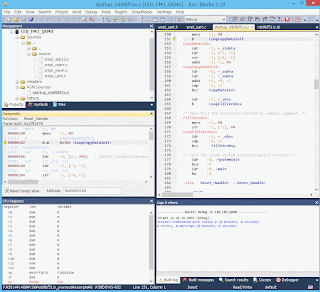hamayan さんのマルチタスク2を SH2A:SH7216 で動作させたので差分をメモします。
GR-SAKURAではじめる超お手軽マルチタスク2
http://hamayan.blog.so-net.ne.jp/2012-12-27
修正箇所はdispatcher_sh2a.srcのみ
;/****************************************************************************/
;/* コンテキストの切り替え処理 */
;/* */
;/* designed by hamayan */
;/* Copyright (C) 2012 hamayan All Rights Reserved. */
;/****************************************************************************/
.export _swi_ctx ;/*実行コンテキストの切替*/
.export _sta_ctx ;/*コンテキストをロードし、タスクを開始*/
;/************************************************
; コンテキストをロードし、タスクを開始
; void sta_ctx(
; void *exe ) //実行コンテキストの保存先
;************************************************/
.section P,CODE,ALIGN=4
_sta_ctx:
sts pr,@-r15 ;/* pr 退避 */
mov.l @r4,r15 ;/*スタックポインタ設定*/
movmu.l @r15+,r6 ;/*r6-r14,prを復帰*/
rts/n
;/************************************************
; 実行コンテキストの切替
; void swi_ctx(
; void *pre, //現在のコンテキストの保存先
; void *post) //切り替えるコンテキスト
;************************************************/
.section P,CODE,ALIGN=4
_swi_ctx:
movmu.l r6,@-r15 ;/*r6-r14,prを退避。r6が最も若いアドレスになる*/
mov.l r15,@r4 ;/*スタックポインタ保存*/
mov.l @r5,r15 ;/*スタックポインタ復帰*/
movmu.l @r15+,r6 ;/*r6-r14,prを復帰*/
rts/n
.end
;/****************************************************************************/
;/* designed by hamayan */
;/* Copyright (C) 2012 hamayan All Rights Reserved. */
;/****************************************************************************/
mul_tsk.c::reg_tsk() を修正したくないので、
R6,R7は余分ですが、退避、回復させています。
また、 STM32F30x での GCC版 のコードもメモしておきます。
修正箇所はdispatcher_cm3.sのみ
;/****************************************************************************/
;/* コンテキストの切り替え処理 */
;/* */
;/* designed by hamayan */
;/* Copyright (C) 2012 hamayan All Rights Reserved. */
;/****************************************************************************/
.syntax unified
.arch armv7-m
.globl swi_ctx ;/*実行コンテキストの切替*/
.globl sta_ctx ;/*コンテキストをロードし、タスクを開始*/
.section .text
;/************************************************
; コンテキストをロードし、タスクを開始
; void sta_ctx(
; void *exe ) //実行コンテキストの保存先
;************************************************/
sta_ctx:
push {lr} ;/*lrを退避*/
ldr r13,[r0] ;/*スタックポインタ設定*/
pop {r4-r12,pc} ;/*r4-r12,pcを復帰*/
;/************************************************
; 実行コンテキストの切替
; void swi_ctx(
; void *pre, //現在のコンテキストの保存先
; void *post) //切り替えるコンテキスト
;************************************************/
swi_ctx:
push {r4-r12,lr} ;/*r4-r12,lrを退避。r4が最も若いアドレスになる*/
str r13,[r0] ;/*スタックポインタ保存*/
ldr r13,[r1] ;/*スタックポインタ復帰*/
pop {r4-r12,pc} ;/*r4-r12,pcを復帰*/
.end
;/****************************************************************************/
;/* designed by hamayan */
;/* Copyright (C) 2012 hamayan All Rights Reserved. */
;/****************************************************************************/
STM32Fシリーズの統合開発環境はEm::Blocksが便利です。
デバッガーにSTLinkが使えるのがうれしい。
http://www.emblocks.org/web/
2014.07.23
























